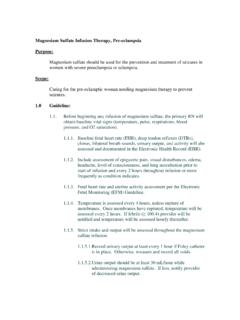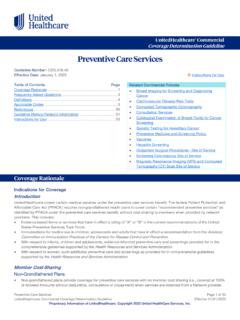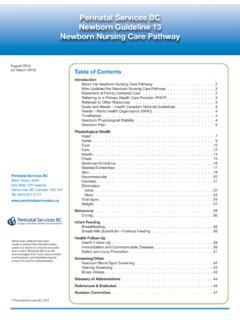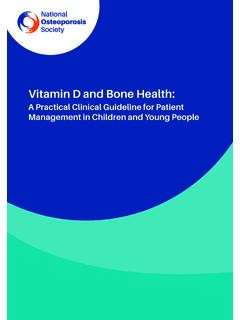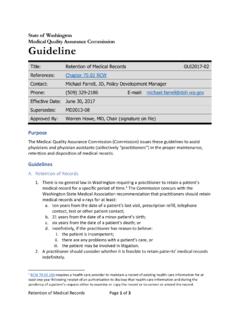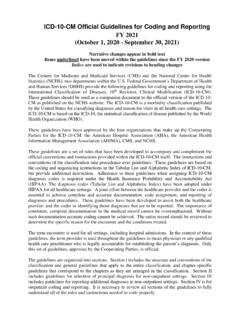Transcription of ANMC Obstetric Hemorrhage Guideline
1 ANMC Obstetric Hemorrhage guidelines 1 ANMC Obstetric Hemorrhage Guideline Content Page Background 2 Differential Diagnosis of Postpartum Hemorrhage 3 Obstetrical Hemorrhage Intervention Strategies 4 Post-partum Hemorrhage Response Algorithms 6 Post PPH Stabilization 9 Appendices: Appendix I: Iron therapy in pregnancy flow cart 10 Appendix II: PPH Risk Assessment Tool 11 Appendix III: QBL tool 12 Appendix IV: L&D Stat Team 13 Appendix V: PPH medication kit 14 Appendix VI: PPH Cart 15 Appendix VII: PPH Instrument Tray 16 Appendix VIII: PPH flow sheet 17 Appendix IX: Blood product guide 18 Appendix X: Surgical options for PPH 19 Appendix XI: Quality review document 21 Appendix XII: PPH Response Algorithm Checklist 23 Appendix XIII: PPH prefilled consent forms 24 Appendix XIV: Debrief tool 25 Revised: 4/6/18 rsg Revised 11/26/17rsg Revised 2/19/14sjh/njm Revised 5/19/11njm ANMC Obstetric Hemorrhage guidelines 2 ANMC Obstetric Hemorrhage Guideline Background The definition of early postpartum Hemorrhage (PPH) is Cumulative blood loss of >1000ml accompanied by signs/symptoms of hypovolemia within 24h following the birth process.
2 PPH is an increasing cause of maternal morbidity and mortality. It accounts for 30% of all maternal deaths worldwide and 10% of maternal deaths in the The rate of postpartum Hemorrhage is steadily increasing throughout developed countries including the Between 1994 and 2006, pregnancy- related Hemorrhage in the has increased 26-27% and is now the leading cause of maternal death. The most common etiology for PPH ( 70-80%) is uterine atony, or a soft, non-contracted uterus. Other causes include retained placenta, lacerations of perineum, vagina, cervix, uterus, retroperitoneum, uterine rupture, pre- existing coagulopathy (inherited or acquired). For a more detailed list, review the next page on the differential diagnosis. Because most of the pregnant population is young and healthy, they don t show signs of cardiovascular stress until the last stage of bleeding. Therefore, recognition of blood loss before cardiovascular changes occur is paramount.
3 Cardiovascular collapse in a young, healthy woman is an emergent, life-threatening situation, which can only be predicted by keeping track of the blood loss throughout the labor course. Although 50% of the PPH occur in women without any risk factors, there is a group of patients who are at high risk of Hemorrhage based on their medical or obstetrical history, including twin-gestation, large infants, long labors, prior uterine surgery and other risk factors indicated in the differential diagnosis below. Patient with a known or suspected abnormal placentation (placenta increta, percreta, accreta) are at extreme risk for PPH. For detailed management of these cases, review the ANMC Guideline : Abnormal placentation management. Due to the alarming increase in PPH events and the potential morbidity and mortality associated with PPH, it is prudent to develop a response system. This system includes standardization of risk factor identification, guidelines on management, and continued training and evaluation of the care given to our patients.
4 From expert reviews it is clear that the direct response to a PPH is multidisciplinary and should be practiced as such in order to keep the tasks and responsibilities pragmatic and clear. This Guideline is developed to be a centrally available tool to use for development and implementation of best practices, as well as a source of review regarding recognition and management of postpartum Hemorrhage at ANMC. This Guideline relied on information from protocols, guidelines and research summarized or done by the American College of Gynecologist (ACOG), the California Maternal Quality Care Collaborative (CMQCC) and World Health Organization. ANMC Obstetric Hemorrhage guidelines 3 Differential Diagnosis of Postpartum Hemorrhage Effective management of postpartum Hemorrhage requires understanding the potential causes. There are four main causes of postpartum Hemorrhage that account for the majority of cases.
5 Also known as the Four T s , these are Tone (uterine atony), Tissue (retained placenta), Trauma (laceration), and Thrombin (coagulopathy). TONE/Uterine atony: Lack of active contraction of the uterine smooth muscle. Accounts for 70-80% of post-partum Hemorrhage . Can be caused by: Infection chorioamnionitis Prolonged induction of labor Prolonged oxytocin use Prolonged second stage of labor Over-distention LGA, multi-fetal pregnancies, polyhydramnios Forceps delivery especially mid-forceps or rotational forceps Previous history of PPH - regardless of etiology Multiparity grand multiparity carries a 4x risk of PPH over baseline Uterine inversion Maternal infusion of magnesium sulfate TISSUE/Retained products of conception: Will cause uterine atony Amnion/chorion (fetal membranes) Abnormal placentation - accreta, increta, percreta, succenturiate lobe, cotyledon fracture Blood clot TRAUMA/Vascular and soft tissue injury.
6 Higher occurrence of tissue trauma with precipitous first and second stages of labor Uterine, cervical, vaginal, perineal lacerations Increased risk with operative vaginal delivery Hematomas- vulvar, paravaginal, broad ligament, retroperitoneal Uterine rupture Non-visible internal bleeding (change in vital signs out of proportion to witnessed blood loss) THROMBIN/Coagulopathy: Inherited Acquired Dilutional - IVF infusion diluting effective clotting factors per ml blood Consumptive Disseminated Intravascular Coagulopathy (DIC), Amniotic Fluid Embolism (AFE) A change of of the INR suggests that almost 80% of clotting proteins have been used ANMC Obstetric Hemorrhage guidelines 4 Obstetrical Hemorrhage Intervention Strategies With current strategies in prenatal care and with modern birthing facilities, there are multiple opportunities to limit risk of PPH as well as maximize response to PPH.
7 Antepartum: Pregnant patients experience a 50% increase in circulating blood volume by 24 weeks gestational age; this persists until delivery. Red blood cell (RBC) mass increases to a lesser degree (25%) than serum volume causing a dilutional anemia. Additionally, there is a dilutional thrombocytopenia and to a lesser extent dilution of coagulation factors. Pregnancy increases iron requirements due to fetal needs as well as maintenance of maternal red blood cell mass. The majority of women can account for iron needs in the non-pregnant state by diet alone. The fold increased need for iron during pregnancy is rarely achieved with diet alone. The antepartum period is an opportunity to maximize maternal RBC mass as well as iron stores. Studies clearly demonstrate that the less anemia and more iron stores a woman has in late pregnancy, the less likely she is to suffer morbidity or need a blood transfusion, even in the setting of mild to moderate PPH.
8 There is a clinical Guideline available for management of iron in pregnancy. See ANMC Anemia In Pregnancy Guideline . See Appendix I: Iron Therapy in Pregnancy. Admission: Every opportunity should be utilized to identify women at risk. However, despite the most robust identification criteria and risk stratification, almost 50% of cases of maternal postpartum Hemorrhage have no identifiable risk factors. This supports the need for identification of those at risk as well as preparedness for those who have no risk factors. Health facility admission represents an ideal time for screening patients for risk factors. The risk assessment should be included on any SBAR (Situation, Background, Assessment, Recommendation) regarding the parturient. Please see Appendix II: PPH risk stratification with recommended management pathways. This risk assessment is dynamic and will change throughout a patient s labor, delivery and postpartum period.
9 As new risk factors develop, this algorithm should be repeated. The presence of multiple risk factors should place them in the high-risk category. Prevention: The majority of Obstetric literature endorses Pitocin as the single most effective management option for prevention/prophylaxis of postpartum Hemorrhage . On the labor unit at ANMC, this is supplied pre- mixed at a concentration of 30U Pitocin in 500ml NS for safety and standardization. Pitocin causes contraction of uterine smooth muscle, effectively closing the maternal circulation to the placental insertion site. It is recommended to initiate Pitocin infusion immediately after delivery of the neonate. Initial rate of infusion is 350ml/h for 30 minutes ( 10 units) after delivery of the neonate followed by continued infusion of Pitocin at 125ml/h for at least 4 more hours. There are no studies that endorse misoprostol for prevention or prophylaxis; however, anecdotal findings suggest that this may be a reasonable adjunct to Pitocin.
10 Once Pitocin has begun, a response to continued postpartum bleeding should progress in a standardized escalating manner that is at once thorough, simple, easy to follow, and effective. It is vital to practice these algorithms frequently so that response to an emergent process becomes second nature. Early and accurate recognition of a postpartum Hemorrhage can prompt a timely and potentially life-saving set of interventions. ANMC Obstetric Hemorrhage guidelines 5 Recognition Qualitative Blood Loss (QBL): Quantitation of blood loss at time of delivery has historically been based on a visual estimate by the provider visual, called estimated blood loss (EBL). To stay ahead of obstetrical Hemorrhage quantification of blood loss should be continuously documented from admission to the end of delivery. Quantification can be done by weighing any delivery materials soaked in blood, by measuring blood in a buttocks drape, and by keeping constant record of those measurements.



